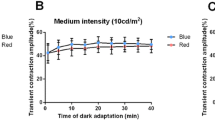Abstract
• Background: In several species there is strong evidence that the retinal dopamine turnover is influenced by retinal dark and light adaptation. In the human retina, dopamine has been found in amacrine and interplexiform cells. • Methods: In the present study, the influence of orally administered levodopa on the human dark adaptation was investigated in healthy subjects using the Goldmann-Weekers adaptometer. To exclude effects of levodopa on the pupil size, a second group was examined after pupil dilation before each examination. A third and fourth group were examined under the same conditions as the first two groups, but without levodopa administration. • Results: Levodopa caused a uniform threshold elevation throughout dark adaptation with undilated and dilated pupils. No effect on sensitivity was observed in the control groups. • Conclusion: These results show a dopaminergic reduction in sensitivity during human dark adaptation.
Similar content being viewed by others
References
Bassi CJ, Powers MK (1986) Daily fluctuations in the detectability of dim lights by humans. Physiol Behav 38:871–877
Bodis-Wollner I, Yahr MD (1978) Measurements of visual evoked potentials in Parkinson's disease. Brain 101:661–671
Borbe HO, Fehske JK, Müller WE, Nover A, Wollert U (1982) The demonstration of several neurotransmitter and drug receptors in human retina. Comp Biochem Physiol 72:117–119
Brainard GC, Morgan WW (1987) Light induced stimulation of retinal dopamine: a dose-response relationship. Brain Res 424:199–203
Calne DB, Reid JL (1972) Antiparkinson drugs, pharmacological and antitherapeutical aspects. Drugs 4:49–74
Dawis SM, Niemeyer G (1986) Dopamine influences the light peak in the perfused mammalian eye. Invest Ophthalmol Vis Sci 27:330–335
Di Paolo T, Harnois C, Daigle M (1987) Assay of dopamine and its metabolites in human and rat retina. Neurosci Lett 74:250–154
Emser W, Dechoux R, Weiland M, Wirz-Justice A (1993) Melatonin decreases the amplitude of the b-wave of the human electroretinogram. Experientia 49:686–687
Frederick JM, Rayborn ME, Laties A, Lam DMK, Hollyfleld D (1982) Dopaminergic neurons in the human retina. J Comp Neurol 210:65–79
Gottlob I, Stangler-Zuschrott E (1990) Effect of levodopa on contrast sensitivity and scotomas in human amblyopia. Invest Ophthalmol Vis Sci 31:776–780
Gottlob I, Strenn K (1990) Effect of levodopa on the human electrooculogram. Clin Vis Sci 5:299–306
Gottlob I, Schneider E, Heider W Skrandies W (1987) Alteration of visual evoked potentials and electroretinograms in Parkinson's disease. Electroencephalogr Clin Neurophysiol 66:349–357
Gottlob I, Weghaupt H, Vass C, Auff E (1989) Effect of levodopa on the human pattern electroretinogram and pattern visual evoked potentials. Graefe's Arch Clin Exp Ophthalmol 227:421–427
Gottlob I, Weghaupt H, Vass C (1990) Effect of levodopa on the human luminance electroretinogram. Invest Ophthalmol Vis Sci 31:1252–1558
Gottlob I, Charlier J, Reinecke RD (1992) Visual acuities and scotomas after one week levodopa administration. Invest Ophthalmol Vis Sci 33:2722–2728
Hamasaki DI, Trattler WB, Hajek AS (1986) Light on depresses and light off enhances the release of dopamine from the cat's retina. Neurosci Lett 68:112–116
Harris P, Calvert JE, Leendertz JA, Phillipson OT (1990) The influence of dopamine on spatial vision. Eye 4:806–812
Hedden WL, Dowling JE (1978) The interplexiform cell system. II. Effect of dopamine on goldfish retinal neurons. Proc R Soc Lond 201:27–55
Iuvone PM, Galli CL, Garrison-Gund CK, Neff NH (1978) Light stimulated tyrosine hydroxylase activity and dopamine synthesis in retinal amacrine neurons. Science 202:901–902
Knapp AG, Dowling JE (1987) Dopamine enhances excitatory amino acid-gated conductances in cultured retinal horizontal cells. Nature 325:437–439
Leguire LE, Rogers GL, Bremer DL, Watson P, Hadjiconstaninou-Neff M (1992) Levodopa and childhood amblyopia. J Ped Ophthalmol Strabismus 29:290–298
Mangel SC, Dowling JE (1985) Responsiveness and receptive field size of carp horizontal cells are reduced by prolonged darkness and dopamine. Science 229:1107–1109
Negishi K, Drujan BD (1979) Effect of catecholamine and related compounds on horizontal cells in the fish retina. J Neurosci Res 4:311–334
Parkinson D, Rando RR (1983) Effects of light on dopamine turnover and metabolism in rabbit retina. Invest Ophthalmol Vis Sci 24:384–388
Parkinson D, Rando RR (1983) Effects of light on dopamine metabolism in the chick retina. J Neurochem 40:39–47
Piccolino M, Neyton J, Gerschenfeld HM (1984) Decrease of gap junction permeability induced by dopamine and cyclic adenosine 3:5-monophosphate in horizontal cells of turtle retina. J Neurosci 4:2477–2488
Proll MA, Morgan WW (1982) Adaptation of retinal dopamine neuron activity in light-adapted rats to darkness. Brain Res 241:359–361
Reme CE, Wirz-Justice A, Terman M (1991) The visual input stage of the mammalian circadian pacemaking system. I. Is there a clock in the mammalian eye? J Biol Rhythms 6:5–29
Schaeffel F, Rohrer B, Lemmer T, Zrenner E (1991) Diurnal control of rod function in the chicken. Vis Neurosci 6:641–653
Skrandies W, Gottlob I (1986) Alteration of visual contrast sensitivity in Parkinson's disease. Hum Neurobiol 5:255–259
Weiler R, Akopian A (1992) Effects of background illuminations on the receptive field size of horizontal cells in the turtle retina are mediated by dopamine. Neurosci Lett 140:121–124
Wirz-Justice A (1987) Light and dark as a “drug”. Prog Drug Res 31:383–425
Wirz-Justice A, Da Prada M, Reme C (1984) Circadian rhythm in rat retinal dopamine. Neurosci Lett 45:21–25
Zarbin M, Wamsley J, Palacios J (1986) Autoradiographic localization of high affinity GABA, benzodiazepine, dopaminergic, adrenergic and muscarinergic cholinergic receptors in the rat, monkey and human retina. Brain Res 374:75–92
Author information
Authors and Affiliations
Rights and permissions
About this article
Cite this article
Gottlob, I., Strenn, K. & Schneider, B. Effect of levodopa on the human dark adaptation threshold. Graefe's Arch Clin Exp Ophthalmol 232, 584–588 (1994). https://doi.org/10.1007/BF00193117
Received:
Revised:
Accepted:
Issue Date:
DOI: https://doi.org/10.1007/BF00193117




